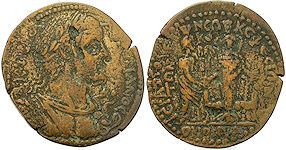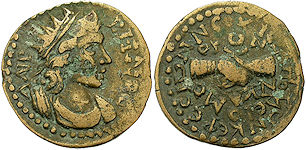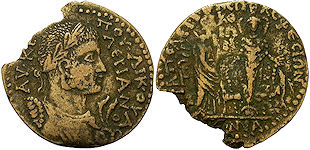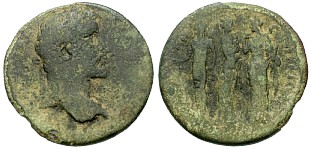Fine Coins Showcase
Antiquities Showcase
Hide empty categories
Shop Search
Shopping Cart
My FORVM
Contact Us
About Forum
Shopping at Forum
Our Guarantee
Payment Options
Shipping Options & Fees
Privacy & Security
Forum Staff
Selling Your Coins
Identifying Your Coin
FAQs
zoom.asp
Home ▸ Catalog ▸ |Themes & Provenance| ▸ |History| ▸ |Homonoia||View Options:   | | | | | | Cities in Thrace and Asia Minor sometimes formed homonoia (alliances) with other cities. The competition for prestige and rivalry between cities in the East was intense. Alliances could enhance a city's status by aligning either with many cities or with particularly important ones. Homonoia was part of civic "foreign policy" and might have involved the exchange of delegates and joint celebrations and sacrifices. At least 87 cities issued homonoia coins celebrating their alliances. |


| The image on the reverse resembles sculptures of Artemis, the Lady of Ephesus, including one at the Ephesus Archaeological Museum and another at the Vatican. The Ionians worshiped Artemis as a mother goddess, akin to the Phrygian Cybele. Her cult image was adorned with multiple rounded breast like protuberances on her chest. They have been variously interpreted as accessory breasts, eggs, grapes, acorns, or even bull testes. Excavation at the site of the Artemision in 1987/8 found a multitude of tear-shaped amber beads that once adorned the ancient wooden xoanon. |  |
Hierapolis, Phrygia, in Homonoia with Ephesos, 253 - 260 A.D.


The title NEOKOPON on the reverse of this type, and other similar coins, has been the topic of debate for more than a century. Hierapolis was honored with a neokoros (imperial temple) either during the reign of Caracalla or Elagabalus. Caracalla rarely gave this honor, but if the honor was given by Caracalla, it would have lasted many decades. If the honor was given during the reign of Elagabalus, as many numismatists and historians believe, it would have been lost with his damnatio. Yet, the title appears here, on a coin struck long after Elagabalus' demise. This coin, however, was struck by Hierapolis honoring its alliance (homonoia) with Ephesos, Ionia. After Elagabalus, at Hierapolis, neokoros titles only appear on homonoia coinage. It seems odd, especially since the title is on the reverse with the name Hierapolis, but the most supported argument is that NEOKOPON refers to a temple at Ephesos, not one at Hierapolis.RP97256. Bronze diassarion, Franke-Nolle, type IX, 760 - 763 (B/49); Weber HpH p. 74 (A/b); Johnston Hierapolis -; BMC Phrygia -; SNG Cop -; SNGvA -; SNG Mün -; SNG Tüb -, gVF, well centered and struck with full legends, nice dark green patina, some porosity, weight 5.120 g, maximum diameter 23.5 mm, die axis 180o, Phrygia, Hierapolis (near Pamukkale, Turkey) mint, time of Valerius and Gallienus, 253 - 260 A.D.; obverse OMONY/A - K EΦEC-IΩN (clockwise from 3:00), laureate, veiled, and draped bust of Boule right; reverse IEPAΠ-O-ΛEITΩN; NEOKO-PΩN in fields, clockwise from lower left, Nike advancing left, wreath in extended right hand, palm frond against left shoulder in left hand; ex Leu Numismatik web auction 13 (15 August 2020), lot 886; this coin is one of only two specimens of this type listed in Coin Archives auction records spanning the last two decades; very rare; SOLD
Gordian III, 29 July 238 - 25 February 244 A.D., Smyrna, Ionia in Alliance with Tralleis, Lydia


In Greek mythology, the Amazons were a nation of all-female warriors Herodotus placed them in a region bordering Scythia in Sarmatia (modern territory of Ukraine). Other historiographers place them in Asia Minor or Libya.RP80383. Bronze AE 31, SNGvA 2249 (same dies); countermark Howgego 774i, gF, weight 16.352 g, maximum diameter 30.9 mm, die axis 180o, Smyrna (Izmir, Turkey) mint, 29 Jul 238 - 25 Feb 244 A.D.; obverse AY KAI M ANT ΓOPΔIANOC, laureate, draped, and cuirassed bust right, countermarked Γ; reverse ΣMYPNAIΩN OMONOIA TPHΛANΩN, turreted and cuirassed Amazon Smyrna (to left) standing right, facing turreted city-goddess of Tralles standing left, ΕΠΠOΛΛI/ANOY exergue; SOLD
Valerian I, October 253 - c. June 260 A.D., Hierapolis, Phrygia in Homonoia with Ephesus


This coin commemorates the homonoia (alliance) between Phrygia and Ephesus. Cities in Thrace and Asia minor sometimes formed alliances with other cities. The competition for prestige and rivalry between cities in the East was intense. Alliances could enhance a city’s status by aligning either with many cities or with particularly important ones. Homonoia was part of civic "foreign policy" and might have involved the exchange of delegates and joint celebrations and sacrifices. At least 87 cities issued homonoia coins celebrating their alliances.RP77254. Bronze AE 35, Franke-Nolle, type VII, 743 (Vs. B/ Rs. 39); cf. BMC Phrygia p. 264, 188; SNG Hunterian 1957; SNG Righetti 1189, aVF, pitting, edge cracks, weight 14.402 g, maximum diameter 34.8 mm, die axis 180o, Phrygia, Hierapolis (near Pamukkale, Turkey) mint, Oct 253 - c. Jun 260 A.D.; obverse AV• KE• - ΠOV ΛIK OYA/ΛEPIANOC, laureate, draped, and cuirassed bust right, wearing aegis from which two snakes rise; reverse IEPAΠOΛEI/TΩN - K EΦECIΩN, Serapis standing right, kalathos on head holding transverse scepter; to right, Artemis Ephesia facing, resting each hand on the head of a stag, one stag flanking on each side, NEΩ/KO/PΩ/N in four lines in center field, OMONOIA in exergue; big 35mm bronze; very rare; SOLD
Hierapolis, Phrygia, in Homonoia with Ephesos, 244 - 249 A.D.


The reverse legend arrangement is bizarre and all the Ω's are upside down, appearing as U. Franke-Nolle lists two specimens from these odd dies. All the other examples referenced are the normal type.RP77246. Bronze AE 23, cf. Franke-Nolle, type IV, 730 (Rs. B/Vs 32); cf. BMC Phrygia p. 261, 179; SNGvA 3662; SNG Cop 474; SNG Munchen 253; SNG Tübingen 4055, VF, well centered, corrosion, weight 5.838 g, maximum diameter 22.6 mm, die axis 180o, Phrygia, Hierapolis (near Pamukkale, Turkey) mint, time of Philip I, 244 - 249 A.D.; obverse ΛAIP-BHNOC, radiate and draped bust of Apollo Lairbenos right; reverse IEPAΠOΛEI/TUN K EΦECIUN NEOK/OPUN, clasped hands, OMO-NOVA in the lower field; extremely rare variant; SOLD
Otacilia Severa, Augusta, February 244 - End of September 249 A.D., Hierapolis, Phrygia in Homonoia with Sardis


This coin commemorates the homonoia (alliance) between Phrygia and Sardis. The wreaths refer to the games sponsored by each of the two cities, the ΠYΘIA games held by Hierapolis, and the XPVCANΘINA games held by Sardes.RP77256. Bronze AE 25, Franke-Nolle, type V, 838 (Vs. A/Rs. 11); cf. Lindgren-Kovacs 976; BMC Phrygia p. 260, 175, F, weight 7.301 g, maximum diameter 25.0 mm, die axis 180o, Phrygia, Hierapolis (near Pamukkale, Turkey) mint, Feb 244 - End Sep 249 A.D.; obverse M ΩT CEVHPA, draped bust right, wearing stephane, hair in horizontal ridges, plait up the back of head; reverse IEPAΠOΛEITΩN K CAPΔ,IANΩN NEΩ/KOPΩN (ending in two lines in exergue), two wreaths side by side with inscriptions within, left wreath XPV/CAN, right wreath ΠVΘ/IA, OMONOI/A in the field above; very rare; SOLD
Hierapolis, Phrygia, in Homonoia with Ephesos, 253 - 268 A.D.


In the cities of ancient Greece, the boule was a council of citizens (bouleutai) appointed to run daily affairs of the city. Originally a council of nobles advising a king, boulai evolved according to the constitution of the city; in oligarchies, boule positions might be hereditary, while in democracies, members were typically chosen by lot and served for one year. The personification of Boule is known from Athenian reliefs. She wears a chiton and a himation, and is veiled or her hair is covered by a sakkos.RP77258. Bronze AE 24, Franke-Nolle, type IX, cf. 755 (B/-, unlisted rev. die); Weber 5905; Johnston Hierapolis -; BMC -; SNG Cop -, SNGvA -, SNG Mün -, SNG Tüb -, et al. -, gF, nice for the grade, porosity, reverse slightly off center, weight 5.663 g, maximum diameter 23.7 mm, die axis 135o, Phrygia, Hierapolis (near Pamukkale, Turkey) mint, 253 - 268 A.D.; obverse K EΦEC-IΩN OMONY/A, laureate, veiled, and draped bust of Boule right; reverse IEPAΠ-OΛITΩN, Nike advancing left, wreath in extended right hand, palm frond against left shoulder in left hand; NEΩKO-ΩN in fields, starting upward on left, last two letters downward on right; very rare; SOLD
Valerian I, October 253 - c. June 260 A.D., Hierapolis, Phrygia in Homonoia with Sardis


This coin commemorates the homonoia (alliance) between Phrygia and Sardis. Cities in Thrace and Asia minor sometimes formed alliances with other cities. The competition for prestige and rivalry between cities in the East was intense. Alliances could enhance a city’s status by aligning either with many cities or with particularly important ones. Homonoia was part of civic "foreign policy" and might have involved the exchange of delegates and joint celebrations and sacrifices. At least 87 cities issued homonoia coins celebrating their alliances. RP77248. Bronze AE 28, Franke-Nolle, type VI, 857 (Vs.C/Rs.18); cf. SNGvA 3668; SNG Tübingen 4054; Lindgren III 596, VF, tight flan, obscure countermark on obverse, weight 9.924 g, maximum diameter 28.1 mm, die axis 180o, Phrygia, Hierapolis (near Pamukkale, Turkey) mint, Oct 253 - c. Jun 260 A.D.; obverse AY• K• - ΠOY• ΛIK• OYAΛEPAN/OC, radiate, draped, and cuirassed bust right, from the front, round countermark on face; reverse IEPAΠOΛE/ITΩN - KE - CAPΔIANΩN, Apollo on left, standing right, plectrum in right hand, kithara (lyre) in left hand; cult statue of Kore facing, wearing kalathos and veil, NEOKOPΩN downward in right field, OMONOYA in exergue; very rare; SOLD
Valerian I, October 253 - c. June 260 A.D., Hierapolis, Phrygia in Homonoia with Ephesus


Hierapolis (Greek: "Holy City") was located on hot springs in Phrygia in southwestern Anatolia. Its ruins are adjacent to modern Pamukkale in Turkey and are designated as a UNESCO World Heritage Site. The hot springs have been used as a spa since the 2nd century B.C., with many patrons retiring or dying there. The large necropolis is filled with sarcophagi.RP77261. Bronze AE 32, Franke-Nolle, type VII, 743 (Vs. B/ Rs. 39); cf. BMC Phrygia p. 264, 188; SNG Hunterian 1957; SNG Righetti 1189, VF, large edge split, weight 10.357 g, maximum diameter 31.9 mm, die axis 180o, Phrygia, Hierapolis (near Pamukkale, Turkey) mint, Oct 253 - c. Jun 260 A.D.; obverse AV• KE• - ΠOV ΛIK OYA/ΛEPIANOC, laureate, draped, and cuirassed bust right, wearing aegis from which two snakes rise; reverse IEPAΠOΛEI/TΩN - K EΦECIΩN, Serapis standing right, kalathos on head holding transverse scepter; to right, Artemis Ephesia facing, resting each hand on the head of a stag, one stag flanking on each side, NEΩ/KO/PΩ/N in four lines in center field, OMONOIA in exergue; very rare; SOLD
Antoninus Pius, August 138 - 7 March 161 A.D., Alliance of Miletus and Smyrna, Ionia


RP80885. Bronze medallion, SGICV 1414; SNGvA 2108, aF, weight 25.067 g, maximum diameter 38.1 mm, die axis 0o, obverse AV KAI TI AΔ ANTΩNEINOC, laureate bust right; reverse MEIΛHCIΩN CMYPNAIΩN, naked Apollo Didymeus standing facing, with stag and bow; to right, two Nemeses standing facing each other; SOLD

You are viewing a SOLD items page.
Click here to return to the page with AVAILABLE items.
The sale price for a sold item is the private information of the buyer and will not be provided.



REFERENCES|
Page created in 1.422 seconds.






